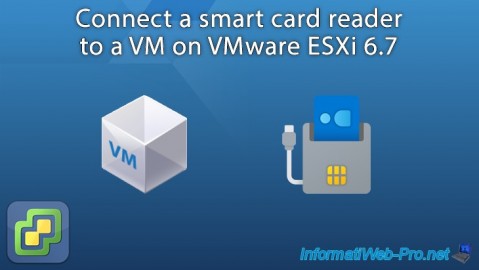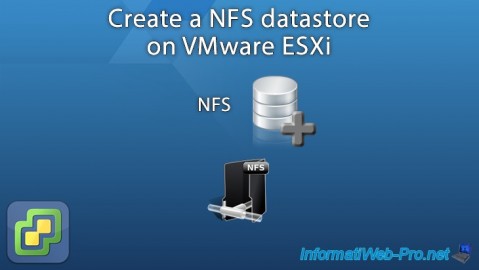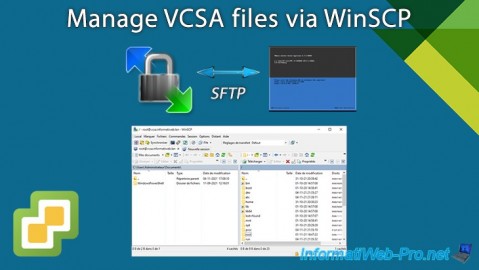Clone virtual machines to a content library on VMware vSphere 6.7
- VMware
- VMware vCenter Server (VCSA), VMware vSphere
- 09 October 2024 at 18:54 UTC
-

- 2/2
2. Clone a virtual machine as an OVF template in a content library
From your VMware vCenter Server, you can also clone a virtual machine as an OVF template to a local content library.
The advantage of this format is that this type of template can be synchronized from a published content library to a subscribed content library. Unlike VM models for which this is not possible.
To begin, right-click the virtual machine to clone, then click: Clone as Template To Library.

To clone the virtual machine to an OVF template:
- select "Template type: OVF"
- select "Clone as: New template" to create a new OVF template in your content library.
Or "Update existing template" to update an already existing item in your content library. - provide a name for this OVF template.
- provide a note for this OVF template (optional)
- choose whether you want to preserve MAC addresses on network adapters or not.
Note that you cannot run 2 virtual machines with the same MAC addresses simultaneously.

Select the content library in which you want to store this OVF template.
Note that unlike VM templates, OVF templates are stored and referenced only in the content library selected here.

A summary appears.
Click Finish.

If you view the list of recent tasks, you will see these tasks appear:
- Transfer one or more files
- Upload files to a library item
- Create a library item
- Export OVF template

You will also see tasks regarding the OVF format used:
- Export OVF template
- Clone into content library OVF module from virtual machine or virtual appliance

The first tasks that will complete are those related to file transfer and uploading files to a library item.

Note that unlike the VM template which appears in the list of virtual machines and in the targeted content library, the OVF template will not appear in the "VMs and Templates" tab of your VMware vCenter Server.

To see it, you will need to click on "vSphere Client", then on: Content Libraries.

Click the name of your content library.

As you can see, this time the type of this template is "OVF Template".

If you click on its name, you will be able to obtain information about this OVF template, including its size, the guest OS (guest operating system) located there, its virtual hardware, ...

As a demonstration, we published our local content library, then created a subscribed content library "RemoteContentLibrary" from our published content library (ContentLibrary).

As you can see, VMware vCenter Server displays this message to you:
Plain Text
You can sync OVF templates only. Synchronization is not available for VM templates.
This explains why our OVF template "Win 10 v2004 x64 - Template OVF" appears in the list of templates in our subscribed content library and the VM template "Win 10 v2004 x64 - Template" does not appear here.
For type "Unknown" and size 0 bytes, this is simply because this item has not yet been synchronized. This element is therefore empty at the moment in our content library, but it can be synchronized unlike the VM model which will never be available here.

Since we selected "Download content immediately" when creating this subscribed content library, there are several tasks running in our case.

Once all background tasks have completed, refresh the page.

Now, VMware vCenter Server tells you that this is indeed an OVF template. The size is also displayed since this item has finished syncing.

3. Delete a VM template
As you have already seen, when you clone a virtual machine as a VM template to a local content library, this VM template appears in 2 places: the desired content library and in the "VMs and Templates" tab.
However, if you go to your VMware vCenter Server storage, you will see that your VM template is only stored in one place.
And more precisely, a folder with the name of the VM template has been created at the root of your datastore.
If you look in the "contentlib-..." folder which corresponds to the targeted content library, you won't find it.
Which means that deleting this VM template in one location will also delete it in the other location.
Note: in our case, the "contentlib-..." folder corresponding to our local content library only contains one folder.
The one corresponding to the OVF template.
Note that for OVF templates, these are only present in the content library previously selected via the clone wizard.
Deleting an OVF template will therefore only delete it from this content library. There is nothing special for this case.

Select the VM template you want to delete.
In our case, we will do it from the "VM and Templates" tab.

Right-click "Delete from Disk" on it.

Confirm the deletion of the VM template (and all files associated with it) by clicking Yes.

As expected, the VM template is gone.

If you go to the content library where this VM template was also located, you will see that it has also disappeared from there.

Indeed, if you look in the recent tasks, you will see that its deletion from the "VM and Templates" tab will also have caused the execution of the task "Delete Library Item" for the target "[name of template deleted]".

Share this tutorial
To see also
-

VMware 6/2/2023
VMware ESXi 6.7 - Connect a smart card reader to a VM
-

VMware 7/29/2022
VMware ESXi 7.0 / 6.7 - Create a NFS datastore
-

VMware 5/15/2024
VMware vSphere 6.7 - Add a physical disk to host
-

VMware 6/19/2024
VMware vSphere 6.7 - Manage VCSA files via WinSCP

No comment